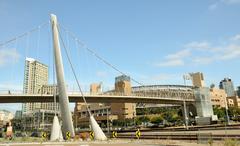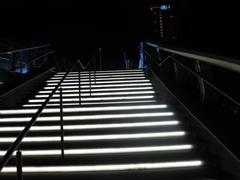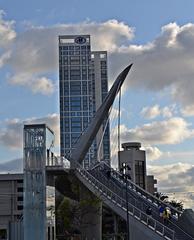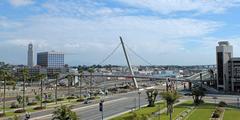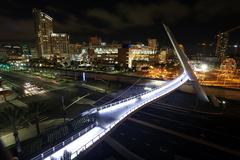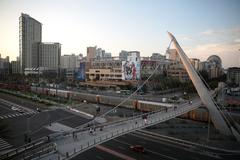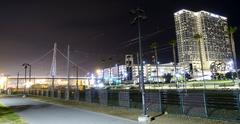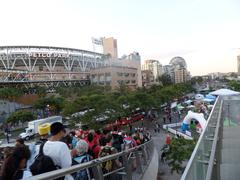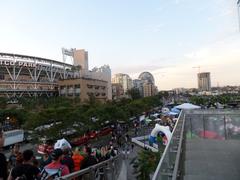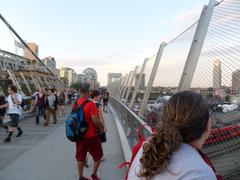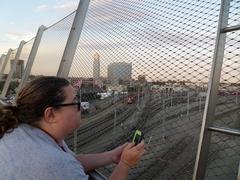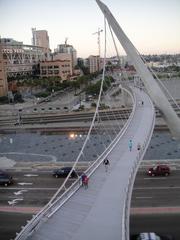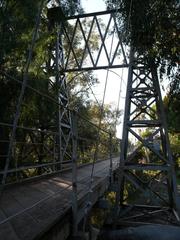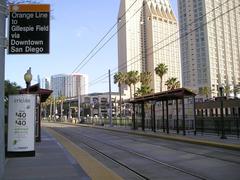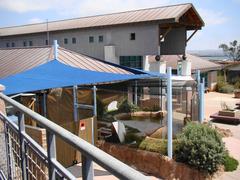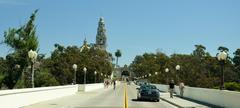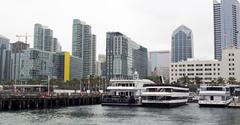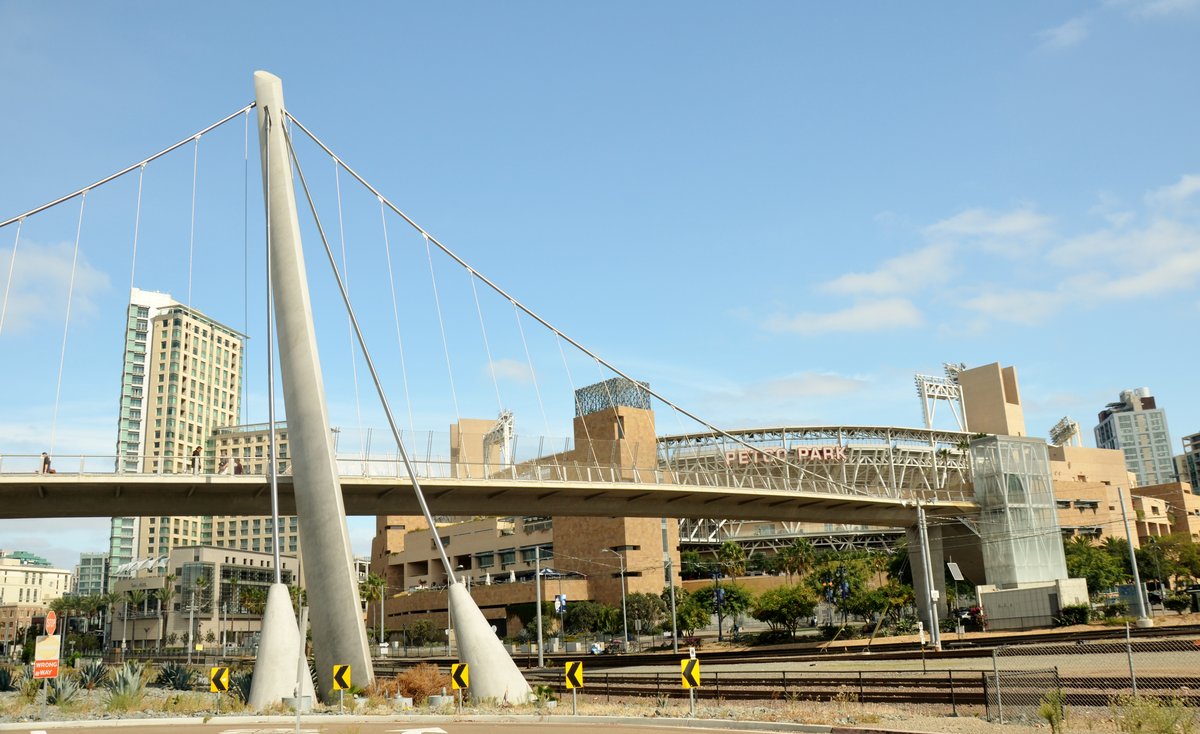
Visiting Harbor Drive Pedestrian Bridge: Hours, Tickets, Historical Sites in San Diego
Date: 01/08/2024
Introduction
Discover the iconic Harbor Drive Pedestrian Bridge, an architectural marvel that embodies the innovative spirit and urban planning excellence of San Diego, California. Completed in 2011, this stunning structure serves as a vital pedestrian and bicycle link between some of the city’s most cherished landmarks, including Balboa Park and the San Diego Bay. The bridge’s history is deeply rooted in a century-old vision to enhance accessibility and aesthetic appeal by connecting key areas of the city (Structure Magazine). Designed by Safdie Rabines Architects and T.Y. Lin International, the bridge features a unique self-anchored suspension design with a single inclined pylon, making it not only a functional piece of infrastructure but also a landmark of modern engineering and design (Archello). This guide will provide you with comprehensive information on the bridge’s history, visitor tips, and its significant impact on the community.
Table of Contents
- Introduction
- History of the Harbor Drive Pedestrian Bridge
- Visitor Information
- Impact on the Community
- Conclusion
- FAQ
History of the Harbor Drive Pedestrian Bridge
Early Vision and Planning
The concept of the Harbor Drive Pedestrian Bridge is deeply rooted in San Diego’s long-term urban planning. The vision of creating a pedestrian and bicycle link between Balboa Park and the San Diego Bay dates back over a century. This ambitious plan aimed to enhance accessibility and aesthetic appeal by connecting the historic park to the scenic bay via downtown.
Challenges and Initial Steps
Several obstacles hindered the realization of this vision, including multiple sets of trolley and freight train tracks and the heavily trafficked Harbor Drive. Recognizing the project’s importance, the City of San Diego commissioned the Centre City Development Corporation (CCDC) in 2004 to design and build a bridge that would complete the approximately 1.9-mile (3 km) route linking Balboa Park to the Bay (Structure Magazine).
Design and Architectural Innovation
The design of the bridge was a collaborative effort involving Safdie Rabines Architects and T.Y. Lin International. Through community outreach meetings, the decision was made to create a self-anchored suspension bridge with a single inclined pylon. This design was chosen for its structural efficiency and potential to become a landmark structure, symbolizing the revitalized downtown San Diego (Structure Magazine).
Construction and Completion
Construction began in earnest, with the bridge’s 500-foot curved span supported by a unique 130-foot tall inclined pylon. This innovative design also features a structural glass elevator tower, enhancing the bridge’s modern aesthetic and providing an additional point of interest for visitors (Archello).
Recognition and Awards
The Harbor Drive Pedestrian Bridge has been widely recognized for its innovative design and engineering excellence, including an Outstanding Award in the New Bridge & Transportation Structures category at the 2012 NCSEA Annual Excellence in Structural Engineering awards program (Structure Magazine).
Visitor Information
Visiting Hours and Tickets
The Harbor Drive Pedestrian Bridge is open 24/7 and is free to visit. No tickets are required, making it an accessible attraction for both locals and tourists.
Travel Tips
- How to Get There: The bridge is conveniently located near the San Diego Convention Center and Petco Park. It is easily accessible by foot, bike, or public transportation.
- Nearby Attractions: While visiting, explore nearby attractions such as the San Diego Bay, Balboa Park, and the bustling Gaslamp Quarter.
- Best Time to Visit: The bridge offers stunning views at any time of day, but sunrise and sunset provide particularly beautiful backdrops for photography.
Impact on the Community
Since its completion in the spring of 2011, the Harbor Drive Pedestrian Bridge has become an iconic feature of San Diego. It provides a vital link between key areas of the city, encouraging more people to explore downtown on foot or by bike, thereby reducing traffic congestion and promoting a healthier lifestyle. The bridge’s striking design has made it a popular destination for both locals and tourists, boosting the area’s appeal and economic vitality (Safdie Rabines Architects).
Conclusion
The Harbor Drive Pedestrian Bridge stands as a testament to visionary urban planning and innovative design. By overcoming significant logistical challenges and incorporating cutting-edge engineering solutions, the project has successfully realized a century-old vision for a Park-to-Bay link in San Diego. Today, the bridge not only serves a practical purpose but also symbolizes the city’s commitment to creating a more connected, accessible, and vibrant urban environment.
FAQ
Q: What are the visiting hours for the Harbor Drive Pedestrian Bridge?
A: The bridge is open 24/7 and is free to visit.
Q: Do I need tickets to visit the Harbor Drive Pedestrian Bridge?
A: No, visiting the bridge is free, and no tickets are required.
Q: How do I get to the Harbor Drive Pedestrian Bridge?
A: The bridge is located near the San Diego Convention Center and Petco Park and is easily accessible by foot, bike, or public transportation.
Q: What are some nearby attractions?
A: Nearby attractions include the San Diego Bay, Balboa Park, and the Gaslamp Quarter.
